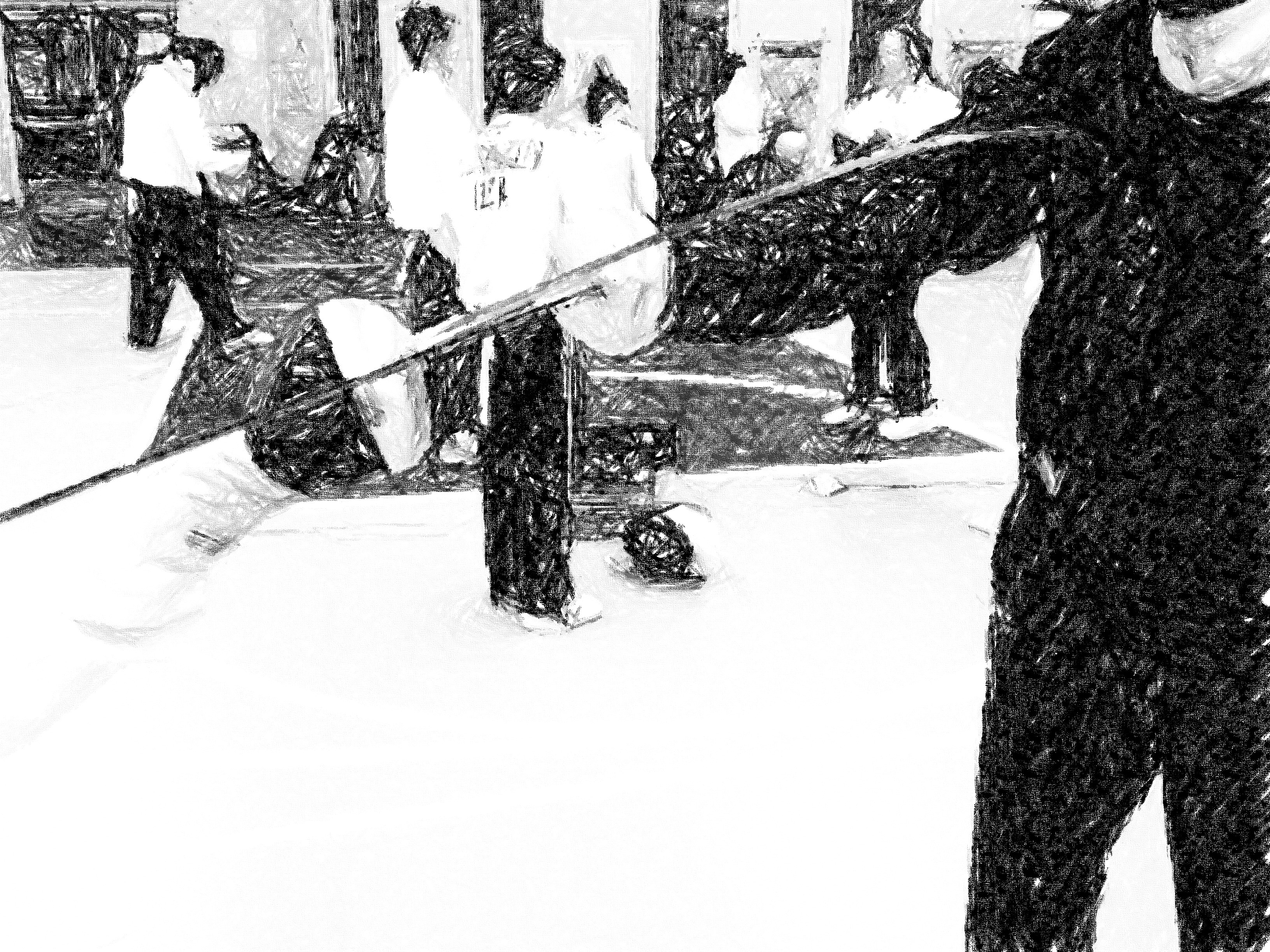I've written for American Fencing magazine, am a former president of the San Diego Scholastic Fencing League, and the author of The Devil's Sword, a mainstream thriller set against the backdrop of this fascinating sport. But just four short years ago I was a novice; a newbie. I was just another parent who knew NOTHING about the sport of fencing.
Sure, I knew that sword fighting was irresistibly appealing to children. Put two kids in a room with long cardboard tubes and within seconds an epic sword fight would begin. I also knew that Hollywood recognized the innate appeal of the sport, as evidenced by the elaborate swordplay in such blockbusters as Star Wars, The Matrix, and Pirates of the Caribbean.
But fencing? The sport of sword fighting? What was that all about? Clanging swords together is nice, but fencing seemed feeble when compared to such behemoths as football, basketball, baseball, soccer, and tennis. These and other great sports at least had the good sense to require a ball; one crying out to be kicked, or hit, or shot, or bounced, or caught, or chased. Sure, fencing was cute and all, and America was achieving unprecedented success in the sport in recent Olympics - but how would it compare to a real sport?
Well, four years ago, when my 12-year-old son took up fencing, I got the surprise of my life. Because I found there was a one word answer to the question, "How does fencing compare to other sports?" And that word is: brilliantly. Two young female fencers competing in saber
Not only did I discover fencing was great fun to watch, but I noticed how quickly sweat would begin pouring from the bodies of seasoned combatants. It didn't look all that taxing, not compared to the two hours of sprinting I regularly did on a tennis court at least. So I tried it myself. I suited up and battled my undersized 12-year-old son. And I made two important discoveries. One, despite my height and speed advantage, I had absolutely zero chance against him. And two, fencing was exhausting! After five or ten minutes I was panting like a dog. It turns out that racing up and down a sidewalk-shaped fencing strip (the sports' playing field) while in a fencing stance, and trying to stay out of reach of a three foot sword being thrust at my chest at astonishing speed, was hard. Hitting my opponent while avoiding being hit myself required considerable quickness, athleticism, and intelligence. And the sport provided a fantastic physical and mental workout; far beyond my wildest expectations. Who knew?
When I was a kid, I lived for sports. So, as a father, I couldn't wait to introduce my son to a wide variety of them. And I did. But although my son was a natural athlete, there was one problem: he had absolutely no interest. Not in any of them.
But then, miraculously, fencing came along. It challenged and excited him in a way those other sports could not. There were endless moves for him to learn. Ways to block an opponent's blade (parry). Ways to attack after a parry (riposte). Ways to avoid the parries and ripostes of an opponent. Ways to set traps. It was chess at 150 miles per hour. To excel, my son needed to think several moves ahead, and the sport required incredible eye-hand coordination, footwork, lightning fast reflexes, and even faster decision-making. It was cool. It was fun. And my son quickly developed a passion for it; something I had given up hope would ever happen when it came to him and athletics.
The sport totally transformed my son:
His self-esteem grew before my eyes.
He became self-assured; confident.
He learned sportsmanship and chivalry. Respect for his coaches and fellow combatants.
He learned teamwork and leadership (as captain of his middle school team).
He tested the limits of his endurance and will, and learned to focus under tremendous pressure.
He forged strong and healthy friendships; and
He got into superb physical and mental shape.
Needless to say, I fell in love with the sport. And not just because of what it was doing for my son, but because it was insanely cool. And although this is a broad generalization, I've found kids who fence are among the nicest, brightest, most helpful, and most respectful kids you would ever want to meet.
So I went from zero knowledge to total immersion in very little time. At my son's first tournament, which was incredibly fun, I realized I was becoming part of a fascinating secret world that only the tiniest minority ever had the chance to experience. I became convinced that many more people would fall in love with the sport if only they were exposed to it. Eventually, I wrote The Devil's Sword to do just this. An action packed thriller designed to appeal to kids and adults, fencers and non-fencers alike. A book in which three teen fencers at a tournament at Nellis Air Force Base become unwilling pawns in a brilliant plot to steal a super-weapon: a plot that somehow revolves around the tournament. A book that would give readers a taste of what fencing is all about.
So what is fencing all about? Well, in a nutshell, fencers can compete with any of three weapons: a foil, an epee, or a saber (all of which have blunt tips and no sharp edges). Each weapon has a different appearance and weight, and scoring with each requires strikes to a different target area. For example, an epee fencer can score with a strike anywhere on the body, head to toe, while a foil fencer can only score with a hit to the torso. Foil and epee points (called touches) can only be scored with the tip of the blade, while a sabre fencer can score a touch by striking with both the tip and the edge of the blade.
But regardless of the choice of weapon, the protective clothing and mask make fencing far safer than traditional sports. Finally, because touches can occur faster than the eye can follow, fencers are typically hooked up to spaghetti-thin, retractable, electrical cords, like divers, so that a light goes off on a scoreboard when they've stabbed their opponent with the proper force.
This brief description doesn't do the sport justice, of course. The more one learns about fencing the more fascinating it becomes. And a cursory summary doesn't even begin to capture the fun, excitement, and unique atmosphere of a tournament.
So I encourage everyone, young and old alike, to find a local fencing club and give this amazing, addictive sport a try; a sport by the way that appeals to girls every bit as much as boys. A sport that can appeal to kids who have never found a passion for any other sport. For some, it will change their lives forever. But even for those who never become addicted, I can promise that trying it even a single time will be a fun, unique, and unforgettable experience.
By Douglas Richards
Read his book about fencing:
The Devil's Sword

.jpg?1480435303371)
